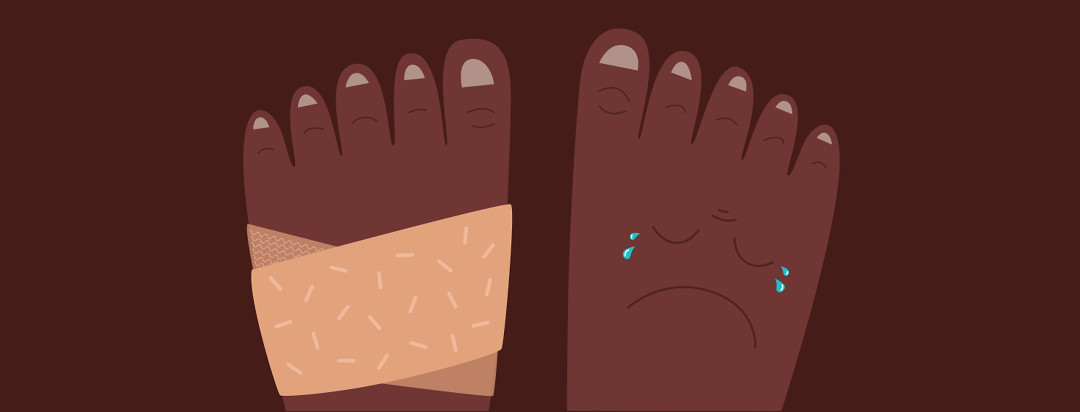How to Improve Your Plantar Fasciitis
Did you know that plantar fasciitis pain that persists for more than 6 weeks is considered “chronic”? Turns out I’ve been chronic for about 4 years then! One common symptom of psoriatic arthritis is enthesitis, or inflammation anywhere in the body where the tendons and ligaments attach to the bone. Enthesitis is a common feature of spondyloarthropathies, including PsA, and it can present itself in a number of different ways - as plantar fasciitis, Achilles tendonitis, temporomandibular joint disorders, and more.1 Classic plantar fasciitis presents as pain that can radiate from your heel all the way through the arch and right to the pad of the foot where the fascia connects. The pain is usually worse in the morning or after long periods of rest and is a serious pain in the butt (foot). Here’s the low down on what you can do to improve it!
Start a Forum
Is my heel pain plantar fasciitis?
First and foremost, make sure that your heel pain is plantar fasciitis and not something else. A diagnosis may come from your primary care physician, a podiatrist, or even physiotherapists and chiropractors. As someone who has been to all four, my best advice would be to skip straight to the podiatrist (these are doctors that specialize in feet and ankles). In Canada, you don’t even need a referral for most of them, which makes the process even speedier.
Stretching to ease pain
The plantar fascia is a thick band of connective tissue that runs along the bottom of the foot. It isn’t very stretchy. You can do your best to stretch it out by flexing your foot and pulling your toes toward you. As with all stretches, stretch only until you are slightly uncomfortable (stretching to the point of pain can cause tears that the body attempts to heal by contracting the muscles/ligaments, which ironically makes you less stretchy!). It’s also important to stretch out your calves. Tight calves can exacerbate the problem. As with other types of inflammation, ice, elevation, and rest can also improve your symptoms. Try freezing a water bottle and rolling it under your foot to alleviate pain.
Using tape and orthotics for support
Taping can be done to relieve pressure on the plantar fascia. It is not recommended to try taping yourself! I’ve found physiotherapists are the best equipped to tape properly (over-taping or taping incorrectly can cause other problems). People who end up with plantar fasciitis often have poor foot mechanics are under/over-pronated arches. A chiropractor or podiatrist can prepare custom orthotic inserts that you slip into your shoes and keep your feet supported. The best orthotics for plantar fasciitis have extra padding in the heels. You can try store bought shoe inserts too, but the custom ones are best if you can afford them.
Wearing night braces or boots
If your plantar fasciitis is more than just a flare, it may be that you are already doing all of the above and not finding enough relief. Time to roll out the big guns! You guys, the day I ordered my night boots was the day my life changed. My boots are made with a sturdy plastic covered in padding. There are three adjustable straps that lock across your shin, ankle, and across the top of the foot. The purpose of night braces is to keep your foot in a flexed position which prevents the fascia or calf from contracting in the night. Night boots/braces will make those first few steps in the morning immensely better. In the same category, many people find wearing compression socks/stockings or socks with extra heel/arch padding help as well.
Laser therapy and shockwave therapy
Although there haven’t been many large-scale studies reviewing the benefits of laser/shockwave therapy, podiatrists have been using them for a long time with great results. The purpose of both procedures is to stimulate healing and break up scar tissue. These therapies are often recommended if the above approaches are unsuccessful, and/or when plantar fasciitis becomes chronic.
Relieving pain from plantar fasciitis
Although now a less favorable option, sometimes corticosteroid injections into the heel pad may be performed to reduce pain and inflammation. While 1-3 treatments may not cause issues, repeated injections can damage the heel tissue and lead to further problems. You may also be prescribed NSAIDs like naproxen or ibuprofen as an anti-inflammatory. Be sure to discuss any other medical conditions that may be affected by NSAID use (NSAIDs can cause psoriasis flares and are also damaging to the stomach lining with prolonged use). My podiatrist also refers patients for acupuncture as an alternative.
Surgical options for plantar fasciitis
In rare occasions, the above treatments may not be enough to heal badly damaged plantar fascia and surgery is the only option. This follows up why I recommend establishing a relationship with a podiatrist straight away. Podiatrists can take you through all these treatments, and they are also the ones who will be able to tell you when surgery is necessary (and may even be the ones to perform the surgery). During the procedure, scar tissue from the plantar fascia will be removed and part of the fascia will be disconnected to relieve pressure. Again, this is rarely required, but good for extreme cases!
What about you? Do you have any tips/tricks for easing plantar fasciitis pain? If you find yourself crawling out of bed/off the couch because you can’t put pressure on your feet without extreme pain after resting, please discuss some of these options with your doctor!

Join the conversation